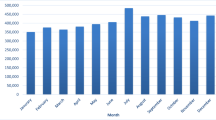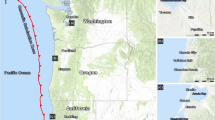Abstract
The south coast of Java has a long history of deadly seismogenic tsunamis. The most recent tsunami events in 1994 and 2006 killed hundreds due to lack of awareness and implementation of disaster mitigation strategies. Community-based tsunami hazard education programs founded on observation of natural warning signs and self-evacuation are critical to saving lives. Students at middle and high schools in three cities along the southern coast of Java (N = 887) participated in a pen/paper survey that included critical awareness, risk perception, self-efficacy, response efficacy, evacuation intentions, past participation in evacuation simulations, communication channels, and warning preferences. Participants generally had high perceived tsunami risk and efficacy. Overall, participants who associated tsunamis with earthquakes know that a receding ocean is a sign of an impending tsunami and believed that vertical evacuation was more important than inland evacuation. School, Internet, and social media were most often reported as information sources. However, the majority of participants believed that an earthquake had to be dramatic to cause a tsunami. Participants overestimated both the duration of ground shaking prior to a tsunami event and the suggested evacuation window. Differences between cities were found for evacuation simulation history and personal experience with tsunamis; however, neither increased critical awareness. Evacuation simulations, coupled with education of under what circumstances to evacuate (20/20/20 principle), should be implemented throughout Java. Short messages stressing that even weak earthquakes can cause tsunamis should be communicated through a variety of channels such as TV, radio, Internet, and social media.
















Similar content being viewed by others
References
Badan Meteorologi Klimatologi dan Geofisika (2010) Laporan Gempabumi Mentawai, 25 Oktober 2010, p 18
Beger G, Priscillia KH, Akshay S (2012) Indonesian youth online—an exploratory study of the Indonesian digital landscape. UNICEF New York, Division of Communication, Social and Civic Media Section
Cox D (2001) The inappropriate tsunami icon. Sci Tsunami Hazards
Dash N, Gladwin H (2007) Evacuation decision making and behavioral responses: individual and household. Nat Hazards Rev 8(3):69–77. doi:10.1061/(asce)1527-6988
Edberg M (2013) Essentials of health behavior. Jones & Bartlett Publishers
Esteban M, Tsimopoulou V, Mikami T, Yun NY, Suppasri A, Shibayama T (2013) Recent tsunamis events and preparedness: development of tsunami awareness in Indonesia, Chile and Japan. Int J Disaster Risk Reduct 5:84–97
Fujii Y, Satake K (2006) Source of the July 2006 west Java tsunami estimated from tide gauge records. Geophys Res Lett. doi:10.1029/2006GL028049
Harris RA (2016) Not that kind of doctor: a story of natural disaster prevention in Indonesia. As Environ Eng Geol (AEG) 59(2):30–36
Harris R, Major J (2016) Waves of destruction in the East Indies: the Wichmann catalogue of earthquakes and tsunami in the Indonesian region from 1538 to 1877. In: Cummins PR, Meilano I (eds) Geohazards in Indonesia: earth science for disaster risk reduction. Geological Society, London, Special Publications, pp 441. doi:10.1144/SP441.2
Harris RA, Prasetyadi C (2002) Who’s next? Assessing vulnerability to geophysical hazards in densely populated regions of Indonesia. Bridges 2:14–17. doi:10.1144/SP441.2
Irawanto DW (2011) An analysis of national culture and leadership practices in Indonesia. J Divers Manag (JDM) 4(2):41–48
Johnston D, Paton D, Crawford GL, Ronan K, Houghton B, Bürgelt P (2005) Measuring tsunami preparedness in coastal Washington, United States. Nat Hazards 35:173–184. doi:10.1007/1-4020-3607-8_12
Johnston D, Becker J, McClure J, Paton D, McBride S, Wright K, Leonard G, Hughes M (2013) Community understanding of, and preparedness for, earthquake and tsunami risk in Wellington, New Zealand. In: Joffe H, Rosetto T, Adams J (eds) Cities at risk: living with perils in the 21st century. Springer, Netherlands, pp 131–148
Lauterjung J, Münch U, Rudloff A (2010) The challenge of installing a tsunami early warning system in the vicinity of the Sunda Arc, Indonesia. Nat Hazards Earth Syst Sci 10:641–646. doi:10.5194/nhess-10-641-2010
Lay T, Kanamori H, Ammon C, Nettles M, Ward S, Aster R, Beck S, Bilek S, Brudzinski M, Butler R, Deshon H, Ekstrom G, Satake K, Sipkin S (2005) The great Sumatra-Andaman earthquake of 26 December 2004. Science 308:1127–1133
LeVeque RJ, Berger MJ et al (2013) Clawpack software 4.6.3. www.clawpack.org. Mar 26, 2013
Løvholt F, Setiadi NJ, Birkmann J, Harbitz CB, Bach C, Fernando N, Kaiser G, Nadim F (2014) Tsunami risk reduction—Are we better prepared today than in 2004? Int J Disaster Risk Sci 10(A):127–142
Mimura N, Yasuhara K, Kawagoe S et al (2011) Damage from the great East Japan earthquake and tsunami—a quick report. Mitig Adapt Strateg Glob Change 16:803–818. doi:10.1007/s11027-011-9297-7
Newcomb KR, McCann WR (1987) Seismic history and seismotectonics of the Sunda Arc. J Geophys Res 92(B1):421–439. doi:10.1029/JB092iB01p00421
Ortiz M, Bilham R (2003) Source area and rupture parameters of the 31 December 1881 Mw = 7.9 Car Nicobar earthquake estimated from tsunamis recorded in the Bay of Bengal. J Geophys Res. doi:10.1029/2002JB001941
Pararas-Carayannis G (2003) Near and far-field effects of tsunamis generated by the paroxysmal eruptions, explosions, caldera collapses and massive slope failures of the Krakatau volcano in Indonesia on August 26–27, 1883. Sci Tsunami Hazards 21:191–211
Paton D (2003) Disaster preparedness: a social-cognitive perspective. Disaster Prev Manag Int J 12(3):210–216. doi:10.1108/09653563310489686
Post J, Wegscheider S, Mück M, Zosseder K, Kiefl R, Steinmetz T, Strunz G (2009) Assessment of human immediate response capability related to tsunami threats in Indonesia at a sub-national scale. Nat Hazards Earth Syst Sci 9(4):1075–1086
Sorooshian S (2005) Meeting the challenges of natural hazards in the wake of the tsunami disaster. EOS Trans AGU 86(2):14. doi:10.1029/2005EO020005
Spahn H, Hoppe M, Vidiarina HD, Usdianto B (2010) Experience from three years of local capacity development for tsunami early warning in Indonesia: challenges, lessons and the way ahead. Nat Hazards Earth Syst Sci 10(7):1411–1429. doi:10.5194/nhess-10-1411-2010
Strunz G, Post J, Zosseder K, Wegscheider S, Mück M, Riedlinger T, Mehl H, Dech S, Birkmann J, Gebert N, Harjono H, Anwar HZ, Sumaryono G, Khomarudin RM, Muhari A (2011) Tsunami risk assessment in Indonesia. Nat Hazards Earth Syst Sci 11:67–82
Sullivan HT, Häkkinen MT (2006) Disaster preparedness for vulnerable populations: determining effective strategies for communicating risk, warning, and response. In: Third annual Magrann research conference at Rutgers University, vol 4, pp 21-04
Suppasri A, Goto K, Muhari A, Ranasinghe P, Riyaz M, Affan M et al (2015) A decade after the 2004 Indian Ocean tsunami: the progress in disaster preparedness and future challenges in Indonesia, Sri Lanka, Thailand and the Maldives. Pure appl Geophys 172(12):3313–3341. doi:10.1007/s00024-015-1134-6
Wichmann CEA (1918) Die Erdbeben des Indishen Archipels Bis Zum Johpe 1857, (in Dutch), Koninkl. Nederlandse Akad. Wetensch. Verh. 2nd Sect. 20, p 193
Wichmann CEA (1922) Die Erdbeben des Indischen Archipels von 1858 bis 1877, (in Dutch) Amsterdam: Konink. Nederlandse Akad. Wetensch. Verh. 2nd Sect. 22, p 209
Acknowledgement
Funding was provided by Utah Valley University (Grant No. GEL Grant 629).
Author information
Authors and Affiliations
Corresponding author
Electronic supplementary material
Below is the link to the electronic supplementary material.
Appendix
Rights and permissions
About this article
Cite this article
Hall, S., Pettersson, J., Meservy, W. et al. Awareness of tsunami natural warning signs and intended evacuation behaviors in Java, Indonesia. Nat Hazards 89, 473–496 (2017). https://doi.org/10.1007/s11069-017-2975-3
Received:
Accepted:
Published:
Issue Date:
DOI: https://doi.org/10.1007/s11069-017-2975-3




